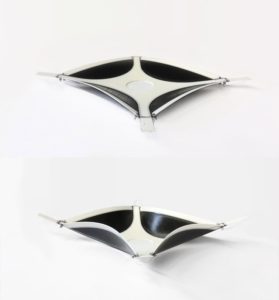Storage trays in cars can be real dustbowls. But they also fulfill a useful function. Where else to store those sunglasses, paper handkerchiefs or a parking disc? A new type of storage tray, developed by the Fraunhofer Institute for Machine Tools and Forming Technology IWU, is concealed in the dashboard and only materializes when needed – a particularly useful feature for car-share vehicles.

© Fraunhofer IWU The two different states assumed by the shape-changing modular tray for a vehicle dashboard.
When purchasing a new car, cockpit design can be a significant factor in the choice of model. For example, are all the various compartments and storage trays positioned in the right place? When renting or sharing a car, however, there is less choice – often, you just have to take what’s on offer. With experts predicting that car sharing is set to grow in the future, automakers are now looking at ways of designing car interiors in such a way that they can be customized to individual requirements.
A simple hand movement to open out a dashboard tray
Researchers at the Fraunhofer Institute for Machine Tools and Forming Technology IWU have teamed up with auto parts company Brose Fahrzeugteile to solve this problem. Their answer? A storage tray that is concealed in the vehicle dashboard and only materializes when required. Should you forget to retrieve your belongings from this tray when leaving the vehicle, the altered shape of dashboard surface will prompt your memory: “The tray open outs like an origami figure,” explains Lukas Boxberger, group manager at Fraunhofer IWU. “This works by means of a shape memory alloy (SMA). These are special materials that are formed into a particular shape until reheated, whereupon they return to their original shape.”
Inspired by a carnivorous aquatic plant
In the case of the dashboard storage tray, a sensor registers a hand movement in the corresponding area of the dashboard. This, in turn, activates the following process: an electric current flows briefly through wires made of a shape memory alloy. These wires connect the pairs of adjacent corners of a square-shaped storage tray. When current flows, the wires heat up, which makes them contract to their original shape. As a result, each of the four corners is pulled evenly towards their common middle point. This exerts a downward pressure on the surface within, thereby hollowing out a tray-like depression on the top ledge of the dashboard. “The idea for the folding mechanism came from a carnivorous aquatic plant,” Boxberger explains. As soon as the driver empties the tray – or if nothing is placed in it – the tray reassumes its original, flat shape. “Current only flows through the wires when the tray is changing shape,” Boxberger says. The system is extremely robust, having completed three million expansion/contraction cycles without noticeable fatigue. Fraunhofer researchers used 3D printing to build a demonstrator.
Plans for industrial production
However, 3D printing is not suitable for mass-production purposes. In a further step, researchers are therefore looking at ways of producing the shape-memory tray by means of injection molding or a roll-to-roll process. Injection molding would only be suitable for producing large-batch production runs. A roll-to-roll process, by contrast, could be used for both small-batch and large-batch production. Here, too, the world of nature served as inspiration – in this instance, the human skin and the muscles beneath it. The skin consists of many layers, each of which fulfills a different function. The epidermis, for example, protects the human body against harmful environmental factors, while the muscles beneath provide movement. Researchers are looking to apply the same principles to the further development of the shape-memory tray: like the epidermis, the tray’s outer layer protects against environmental influences; its receptive layer contains sensors to register hand movements in the area of the tray; an endoskeleton made of a more robust plastic provides strength and movement control; and the SMA wires form the muscles and deliver movement. Researchers will now be examining whether these individual layers are best bonded adhesively, pressed together or printed. Their task will be to develop manufacturing processes that deliver a high-grade, recyclable product while also being economic and environmentally sound.
Looking further ahead, there are also plans to create other shapes – for deeper storage trays – and to make the trays out of other materials such as wood veneer or textiles. Other automotive applications are also perfectly conceivable: self-activating sun blinds, automatic ventilation inlets and outlets, or personalized seat positions.